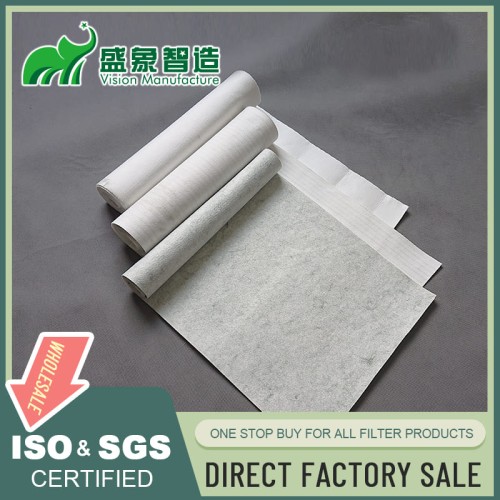
How Does Spunlace Nonwoven Fabric Enhance Filtration and Industrial Applications?
I. Introduction
Spunlace nonwoven fabric is a pivotal material in the filtration and industrial sectors, known for its versatility and high performance. This technology utilizes high-pressure water jets to entangle fibers, creating a fabric with unique properties. This article explores the significance of spunlace nonwoven fabric, its advantages, and its critical role in various industrial processes.
II. Manufacturing Process
- Fiber Preparation and Web Formation: Fibers are initially prepared and laid out in a web, which forms the base structure of the nonwoven fabric.
- Hydroentanglement Process: High-pressure water jets interlock the fibers, enhancing the integrity and strength of the fabric without the use of binders.
- Finishing and Post-Treatment Options: Includes processes like drying, aperturing, and surface treatments to enhance the fabric's properties and performance.
III. Properties of Spunlace Nonwoven Fabric
- Strength and Durability: Provides significant resistance to tearing and abrasion, making it suitable for demanding applications.
- Absorbency and Wicking Capabilities: Highly absorbent and capable of managing moisture, ideal for wipes and hygiene products.
- Softness and Drapability: Offers a cloth-like feel, which is essential for applications requiring comfort and flexibility.
- Chemical Resistance: Resists various chemicals, making it suitable for industrial and cleaning tasks.
- Lint-Free Characteristics: Crucial for applications where contamination control is necessary, such as in cleanrooms.
IV. Applications in Filtration
- Air Filtration Systems: Used in HVAC systems and air purifiers to remove contaminants from air.
- Liquid Filtration Processes: Filters impurities from water and other liquids in industrial and consumer products.
- Automotive Filters: Essential for cabin air filters and other filtration needs within vehicles.
- HVAC Applications: Improves air quality and system efficiency in residential and commercial buildings.
V. Other Industrial Applications
- Medical and Healthcare Products: Includes items like surgical gowns, face masks, and wound care materials.
- Wipes and Cleaning Materials: Utilized in both consumer and industrial cleaning wipes due to its strength and absorbency.
- Geotextiles and Construction: Helps in soil stabilization and erosion control.
- Automotive Interiors: Used for interior trims and acoustic insulation due to its sound-absorbing properties.
VI. Advantages Over Other Nonwovens
- Comparison with Spunbond and Meltblown: Spunlace fabrics typically offer greater strength and softness, making them more suitable for certain applications.
- Benefits in Specific Applications: Provides a balance of durability, absorbency, and softness, enhancing product performance.
- Cost-Effectiveness Analysis: Often more economical in large-scale production compared to other nonwoven fabrics.
VII. Customization Options
- Fiber Blends and Compositions: Can be customized with various fiber types to meet specific needs.
- Basis Weight Variations: Adjustable weights to suit different application requirements.
- Surface Treatments and Finishes: Treatments can enhance properties like hydrophobicity or flame retardance.
- Patterning and Embossing: Adds aesthetic and functional value to the fabric.
VIII. Performance Characteristics
- Filtration Efficiency Ratings: High efficiency in particle capture, suitable for stringent filtration requirements.
- Pressure Drop Considerations: Designed to minimize resistance to airflow, enhancing system efficiency.
- Durability and Lifespan: Long-lasting performance under various operational conditions.
- Chemical and Temperature Resistance: Withstands harsh environments, maintaining functionality.
IX. Environmental Considerations
- Biodegradability of Natural Fiber Spunlace: Offers environmentally friendly options with natural fibers.
- Recycling Potential of Synthetic Spunlace: Synthetic variants can be recycled, reducing environmental impact.
- Energy Efficiency in Production: Spunlace manufacturing is generally less energy-intensive compared to other nonwoven processes.
- Sustainable Manufacturing Practices: Commitment to reducing ecological footprint through responsible production methods.
X. Innovations in Spunlace Technology
- Advanced Fiber Combinations: Enhancements in fiber blending for improved performance.
- Nanofiber Incorporation: Utilizes nanotechnology to increase filtration efficiency.
- Smart and Reactive Fabrics: Incorporates functionalities like temperature responsiveness or antimicrobial properties.
- Biodegradable Options: Develops eco-friendly materials that degrade naturally without harming the environment.
XI. Quality Control and Testing
- Standard Test Methods: Ensures product consistency and reliability through rigorous testing.
- Performance Criteria for Various Applications: Tailors products to meet specific industry standards and customer expectations.
- Regulatory Compliance and Certifications: Adheres to international safety and quality standards.
XII. Case Studies and Success Stories
- Improving Filtration Efficiency in Automotive Applications: Demonstrates how spunlace nonwovens enhance air quality inside vehicles.
- Enhancing Product Performance in Medical Textiles: Shows the benefits in medical applications, such as in surgical drapes and gowns.
- Solving Filtration Challenges in Industrial Cleaning Processes: Highlights the effectiveness in high-demand cleaning tasks.
XIII. Future Trends and Developments
- Emerging Applications for Spunlace Nonwovens: Explores new markets and innovative uses for spunlace fabrics.
- Advancements in Manufacturing Technology: Continues to enhance production efficiency and fabric quality.
- Integration with Other Materials and Processes: Develops composite materials that offer enhanced properties for specialized applications.
XIV. Conclusion
Spunlace nonwoven fabric stands out as a versatile and high-performance material in both filtration and industrial applications. Its unique properties and adaptability make it a preferred choice for manufacturers seeking to improve product quality and operational efficiency across various sectors.
Leave a comment

